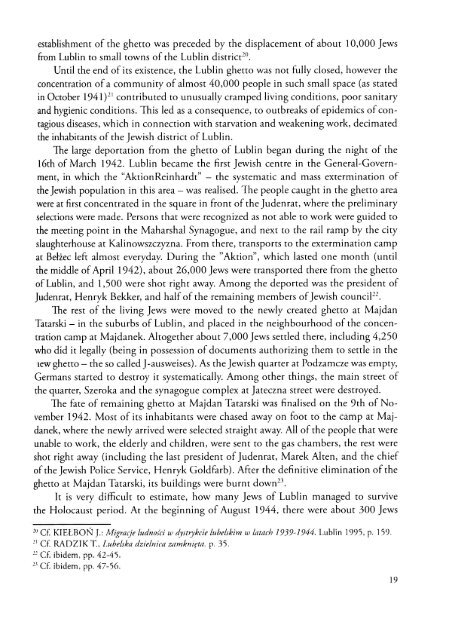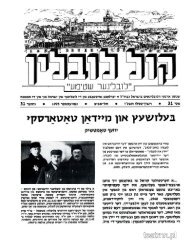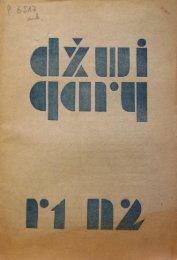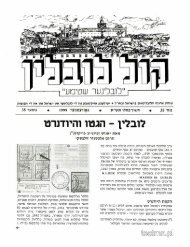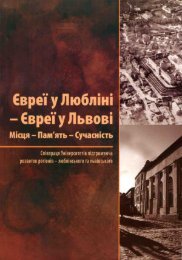The Jews in Lublin - Biblioteka Multimedialna Teatrnn.pl - Brama ...
The Jews in Lublin - Biblioteka Multimedialna Teatrnn.pl - Brama ...
The Jews in Lublin - Biblioteka Multimedialna Teatrnn.pl - Brama ...
Create successful ePaper yourself
Turn your PDF publications into a flip-book with our unique Google optimized e-Paper software.
establishment of the ghetto was preceded by the dis<strong>pl</strong>acement of about 10,000 <strong>Jews</strong><br />
from Lubl<strong>in</strong> to small towns of the Lubl<strong>in</strong> district 20 .<br />
Until the end of its existence, the Lubl<strong>in</strong> ghetto was not fully closed, however the<br />
concentration of a community of almost 40,000 peo<strong>pl</strong>e <strong>in</strong> such small space (as stated<br />
<strong>in</strong> October 1941) 21 contributed to unusually cramped liv<strong>in</strong>g conditions, poor sanitary<br />
and hygienic conditions. This led as a consequence, to outbreaks of epidemics of contagious<br />
diseases, which <strong>in</strong> connection with starvation and weaken<strong>in</strong>g work, decimated<br />
the <strong>in</strong>habitants of the Jewish district of Lubl<strong>in</strong>.<br />
<strong>The</strong> large deportation from the ghetto of Lubl<strong>in</strong> began dur<strong>in</strong>g the night of the<br />
16th of March 1942. Lubl<strong>in</strong> became the first Jewish centre <strong>in</strong> the General-Government,<br />
<strong>in</strong> which the "AktionRe<strong>in</strong>hardt" — the systematic and mass exterm<strong>in</strong>ation of<br />
the Jewish population <strong>in</strong> this area — was realised. <strong>The</strong> peo<strong>pl</strong>e caught <strong>in</strong> the ghetto area<br />
were at first concentrated <strong>in</strong> the square <strong>in</strong> front of the Judenrat, where the prelim<strong>in</strong>ary<br />
selections were made. Persons that were recognized as not able to work were guided to<br />
the meet<strong>in</strong>g po<strong>in</strong>t <strong>in</strong> the Maharshal Synagogue, and next to the rail ramp by the city<br />
slaughterhouse at Kal<strong>in</strong>owszczyzna. From there, transports to the exterm<strong>in</strong>ation camp<br />
at Bełżec left almost everyday. Dur<strong>in</strong>g the "Aktion", which lasted one month (until<br />
the middle of April 1942), about 26,000 <strong>Jews</strong> were transported there from the ghetto<br />
of Lubl<strong>in</strong>, and 1,500 were shot right away. Among the deported was the president of<br />
Judenrat, Henryk Bekker, and half of the rema<strong>in</strong><strong>in</strong>g members of Jewish council 22 .<br />
<strong>The</strong> rest of the liv<strong>in</strong>g <strong>Jews</strong> were moved to the newly created ghetto at Majdan<br />
Tatarski - <strong>in</strong> the suburbs of Lubl<strong>in</strong>, and <strong>pl</strong>aced <strong>in</strong> the neighbourhood of the concentration<br />
camp at Majdanek. Altogether about 7,000 <strong>Jews</strong> settled there, <strong>in</strong>clud<strong>in</strong>g 4,250<br />
who did it legally (be<strong>in</strong>g <strong>in</strong> possession of documents authoriz<strong>in</strong>g them to settle <strong>in</strong> the<br />
lew ghetto — the so called J-ausweises). As the Jewish quarter at Podzamcze was empty,<br />
Germans started to destroy it systematically. Among other th<strong>in</strong>gs, the ma<strong>in</strong> street of<br />
the quarter, Szeroka and the synagogue com<strong>pl</strong>ex at Jateczna street were destroyed.<br />
<strong>The</strong> fate of rema<strong>in</strong><strong>in</strong>g ghetto at Majdan Tatarski was f<strong>in</strong>alised on the 9th of November<br />
1942. Most of its <strong>in</strong>habitants were chased away on foot to the camp at Majdanek,<br />
where the newly arrived were selected straight away. All of the peo<strong>pl</strong>e that were<br />
unable to work, the elderly and children, were sent to the gas chambers, the rest were<br />
shot right away (<strong>in</strong>clud<strong>in</strong>g the last president of Judenrat, Marek Alten, and the chief<br />
of the Jewish Police Service, Henryk Goldfarb). After the def<strong>in</strong>itive elim<strong>in</strong>ation of the<br />
ghetto at Majdan Tatarski, its build<strong>in</strong>gs were burnt down 23 .<br />
It is very difficult to estimate, how many <strong>Jews</strong> of Lubl<strong>in</strong> managed to survive<br />
the Holocaust period. At the beg<strong>in</strong>n<strong>in</strong>g of August 1944, there were about 300 <strong>Jews</strong><br />
20 Cf. KIEŁBOŃ J.: Migracje ludności w dystrykcie luhebkim w latach 1939-1944. Lubl<strong>in</strong> 1995, p. 159.<br />
21 Cf. RADZIK T., Lubelska dzielnica zamknięta, p. 35.<br />
22 Cf. ibidem, pp. 42-45.<br />
23 Cf. ibidem, pp. 47-56.<br />
19


